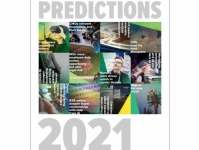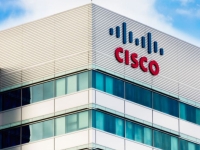Technology
2021 TECHNOLOGY FORECASTS FROM FORRESTER - THE COVID EFFECT PART THREE
2021 TECHNOLOGY TRENDS PART 3 OF 3

What do the Tarot Cards hold for Tech in 2021? (Source: Jen Theodore on Unsplash)
USPA NEWS -
As Sharyn Leaver, Senior Vice President of research at Forrester, said, “The events of 2020 tested businesses like never before. Some did things that, until then, seemed impossible. And, in some cases, that happened literally overnight.“ Leaver adds “Heading into 2021, businesses will continue to be tested, and those that respond with agility, resilience and an unwavering customer focus, will thrive“.
In this report I highlight some of the key predictions that Forrester is making for 2021. There is a total of twelve, and I´ll shall summarize each and then, in the summary, list out the few that I believe really stand out in my mind from a COVID perspective. We´re going to see changing work models, different technology developments and changing consumer requirements.
In this report I highlight some of the key predictions that Forrester is making for 2021. There is a total of twelve, and I´ll shall summarize each and then, in the summary, list out the few that I believe really stand out in my mind from a COVID perspective. We´re going to see changing work models, different technology developments and changing consumer requirements.
INTRODUCTION
I think all twelve predictions are important to a (nearly) post-COVID pandemic world. I say “nearly“ because, as I´ve said before, I don´t see us returning to the same state we were in before COVID-19. It looks like this sort of thing will occur in the future as it has done in the past (the 1918-1919 “Spanish“ flu ““ that wasn´t really Spanish, and the more recent 2002-2004 SARS (severe acute respiratory syndrome) outbreak as examples). We are still living with the aftermath of the 911 attacks on the US in 2001. Most people are still taking their shoes off and putting their laptops through the x-ray machines before boarding a commercial airplane, and are not allowed to bring onboard scissors, box-cutters or liquids above a certain size. So it will be with COVID-19. Many Asian countries already wear masks after SARS and Bird-flu, and many around the world will continue to wear masks, practice social distancing and wash their hands, even after “˜herd immunity´, owing to potential new strains and variants, and the possibility of new viruses altogether. So, let´s start with the first prediction which is really related to social distancing“¦1. Consumers compelled toward escapism
Forrester says “Social distancing tempts another 10% to 12% of US consumers to try extended reality.“ This is interesting as Forrester talks about how “The strain of fluctuating between fear and want; fulfilling domestic and professional obligations simultaneously; contending with feelings of isolation; and navigating political and social unrest will compel consumers toward escapism. Consumers will become more willing to try out new forms of consumption that promise a rush of comfort, control, and happiness “” even if the experiences are entirely simulated.“ They go on to suggest that “Extended reality, which includes augmented, mixed, and virtual reality technologies, will enable this trend.“ This is particularly apparent to me as my 18-year-old son is fulfilling this prophecy having acquired an “˜Oculus Quest´, and I have to say, I can see why folks like it. Safely engage in remote multi-player games with no chance of contracting COVID-19!2. CMOs reinvent themselves and their teams
Forrester says, “Spend on loyalty and retention marketing will increase by 30% as CMOs (Chief Marketing Officers) assert control over the full customer lifecycle“. Forrester suggests that CMO´s will, in effect, take a more “˜hands-on´ approach with their teams. They add, “If they haven´t already, leading CMOs will integrate marketing and customer experience in the coming months. Segregating acquisition from everything that happens after a prospect completes a purchase “” product utilization, customer service, retention, advocacy “” was always a bad idea. Now, pandemic conditions make this disconnect perilous. Disjointed experiences cost millions and lose customers “” they are the antithesis of customer obsession“.We are already seeing this in many organizations. Sales and Marketing are no longer seen as separate solos. Some forward-looking companies like Cisco Systems have gone as far as appointing a single EVP and Chief Sales and Marketing Officer (Gerri Elliott in Cisco´s case, a pre-COVID appointee). These companies will focus on using marketing to help sales retain customers and use loyalty programs to fend off competitors. The cost of acquiring new customers and accounts can be as much as ten times the cost retaining and growing existing ones by many estimates.
I would add that many companies are including transformation and change management as key components of their post-COVID recovery. Using Cisco as an example again, sales are undergoing training to transform the way they approach customers. Go high and grow the business by helping their customers transform. Successful companies will not just rely on existing relationships or run-rate business.
3. CX leaders renovate, not just decorate
The next prediction is “25% of brands will achieve statistically significant advances in CX quality in 2021“. Forrester´s Customer Experience Index (CX Indexâ„¢) found that ““¦the year´s advancers (companies) did the work to determine what really matters to their customers, identified projects to improve important experiences, prioritized the efforts with the biggest potential upside for customers and the business, and then trained their employees (and gave them new tools) so that they could deliver the right experiences consistently. These are the kind of strategic efforts that will build on themselves and begin to change the landscape for CX within industries. They´re strategic and self-reinforcing because they produce business results.“ Forrester sees a consolidation of spend, CX tools and technologies, and a recognition of the value of remaining technologies.4. CIOs lead the bold disruptors
Forrester estimates that “30% of firms will increase spend on cloud, security and risk, networks, and mobility.“ This is born out by my own research. The key to successful growth coming out of the pandemic is based on all these so that workers, managers and executives are empowered to execute, collaborate and lead. Forrester goes on to say, “In fact, CIOs focused on employee experience (EX) will help their firms attract, develop, and retain talent that can provide competitive advantage in a critical year. They will make the needed investments to foster social collaboration, make information easier to find and use, and provide security that´s less distracting“. This will help minimize attrition and create a more strategic approach.5. COVID-19 changes leadership and hiring practices forever
Like most other analysts Forrester see a big increase in remote work. More on the implications of that later. So, “Remote work will rise to 300% of pre-COVID levels. In 2021, at least 21% of US information workers will work primarily from home, compared with 7% in 2019“. Some companies will make some remote work permanent, workers suggest they desire it, but most companies will employ a hybrid mode. That means hiring practices will be more remote too, and “Expect this to reshape talent acquisition, moving right into talent poaching“¦“. Look out for better tools for HR, more budget, more AI (Artificial Intelligence) to sort talent, more focus on remote employee wellness and watch for the possibly that ““¦occupational health and safety claims for injuries that occur while working from home pile up“.6. With more employee data comes opportunity “” but also legal risk
“Regulatory and legal activity related to employee privacy infringements will double“. This was something I hadn't given a lot of thought to, but expect legal departments are going to have to take notice of that.Forrester thoughts here are that, “While European regulators are already enforcing privacy rules to protect employees´ personal data, countries such as Brazil, India, and Thailand will soon do the same. And in the US, given the corporate practices and policies that often limit or deny employees a right to privacy, the battle to determine what is a reasonable expectation of workplace privacy will be fought in the courts“. They expect employee privacy lawsuits to multiply in the next 12 months. Companies must take a “privacy by design“ approach when handling employee personal data, and communicate transparently with employees.
7. REMOTE WORK DRIVES UPTICK IN INSIDER THREATS
Expect an “˜uptick´ means going from a quarter of all attacks are insiders to a third: “33% of data breaches will be caused by insider incidents, up from 25% today“. “This will simultaneously require Chief information security officers (CISOs) and security and risk leaders to adapt while remaining resilient“. Forrester believes three things will push up attacks: 1) the rapid push of users, including some outside of companies´ typical security controls, to remote work as a result of the COVID-19 pandemic; 2) employees´ job insecurity; and 3) the increased ease of moving stolen company data. Combined, these will produce an increase of 8 percentage points in insider incidents, from 25% today to 33% in 2021. Better investigatory and identification will also push up the number of attacks: some are missed right now as insiders. It is believed that better employee treatment can help reduce the motivations for attacks.8. WORKPLACE AUTOMATION AND AI ARE HERE TO STAY
Like many of the pandemic´s effects, automation and Artificial Intelligence (AI) are here to stay. “35% of companies will double down on workplace AI“. Forrester says, “Eighteen million US workers will work from home in the wake of the pandemic, from knowledge workers to cubicle workers“. Expensive labor-intensive activities such as employee self-service, customer service support, and document extraction, will become automated. Forrester thinks that“¦“by the end of 2021, one out of every four remote workers will be supported by new forms of automation, either directly or indirectly. Direct support will be the rarer form “” giving a bot to individual workers to support their daily journey. But indirect support will blossom, as robotic process automation (RPA) bots combined with conversational intelligence and other intelligent automation will handle business tasks often invisible to the home worker“.9. DIGITAL PATHWAYS BRING B2B MARKETERS CLOSER TO BUYERS
More than a third of B2B technology buyers will rate chatbots as a top-10 engagement channel, is the prediction here. The coronavirus pandemic has accelerated the digital destinies of B2B buyers and marketers. “Today, more than one-third of B2B technology buyers say digital engagement channels (such as vendor websites) have become more important in their buying journeys, while around four in 10 indicate that human/analog engagement with sellers has become less important“. This is giving rise to new “˜AI-powered martech´. Apparently 80% of B2B companies are still not embracing these technologies, but the leading 20% companies are actually embracing the use of chatbots and virtual assistant technologies, and “are ready to scale more automated conversations with these buyers“. Given these improvements, Forrester predicts “more than a third of B2B technology buyers will rate chatbots as a top-10 engagement channel in their buying journeys“.10. B2B SELLERS DEEPEN BUYER RELATIONSHIPS WITH HELP FROM AI
This is a prediction that again looks at the importance of AI and automation. “More than 60% of B2B sellers will be enabled by AI and automation“.Forrester tells us that: “To thrive in 2021 and beyond, B2B sellers will need the right enablement tools to enhance their productivity and engage with prospects and customers in more meaningful ways“. Adoption of these tools will allow companies to conduct deeper customer research, cull insights from data, and orchestrate more meaningful interactions with buyers. Forrester also says “In 2021, we predict that more than 60% of B2B sellers will be enabled by AI and automation“. Fifty-seven percent of B2B sales leaders told Forrester they plan to make deeper investments in tools with AI and automation in the upcoming fiscal year. “Sales tools that capture and automatically upload buyer and seller activity data to CRM systems will finally take sellers out of the data entry game“.
11. CLOUD TAKES CENTER STAGE IN PANDEMIC RECOVERY
Forrester, like many of us, knows that the pandemic “reinforced the tremendous value and necessity of cloud computing to the world´s economy and workforce. Without cloud apps, tools, and services, businesses could not have sent millions of workers home, maintained global supply chains, or shifted entire industry business models in a matter of weeks“. It separated successful companies from the not-so-successful. It was already underway of course, the pandemic just accelerated it. As Forrester notes: “The changes brought about by COVID-19 forced companies to prioritize speed and customer experience over cost savings and efficiency “” and they flocked to public cloud services faster than ever. Etsy spun up new Google Cloud infrastructure to meet a spike in e-commerce; Lowe´s got a curbside pickup app running in three days; and Moderna is using AWS to accelerate COVID-19 vaccine research“. Forrester now predicts that ““¦the global public cloud infrastructure market will grow 35% to $120 billion in 2021 and that Alibaba Cloud will take the number three revenue spot globally, after AWS and Azure“.12. EDGE IS THE NEW CLOUD
Readers will know from previous IoT articles that I´ve written that “˜The Edge´ is critical to how organizations will come out of the pandemic. Forrester reminds us that “edge computing is essentially bringing computing closer to where data is generated and where action on the data can be taken“. Forrester now thinks that, “In 2021, we will see new business models emerge that facilitate the deployment of edge, efforts by cloud platforms to compete, and AI and 5G facilitating the expansion of edge use cases“. This is essentially a message of “˜better together´. No single technology is the answer, but complementary technologies providing a synergistic approach.Forrester sees the edge vendors capturing more cloud business over time. The reasons, says Forrester are threefold: “First, consider that large vendors such as Dell, HPE, IBM, and Intel are doubling down on the edge with cloudlike solutions deployable to anywhere. Second, content delivery networks and data center colocation vendors are offering edge compute services across hundreds or thousands of local points of presence, which helps business systems that are more responsive and contextual. Finally, edge innovation marketing is heating up “” there was more venture investment in Q1 of 2020 than all of 2019“. They see a move away from rigid datacenter clouds towards more of an edge strategy for the eventual winners.
CONCLUSIONS
So, there you have it. Twelve predictions. For me they are all important, but the most COVID-19 pandemic recovery related ones to my mind are numbers 4, 5, 7, 8, 11 and 12. Perhaps numbers 5 and 8 will have the biggest impact on employees ““ remote work being the most visible change that many companies and employees are experiencing ““ with organizations still deciding how to move forward. Remote? Back to the office? Hybrid? When? Those are some of the biggest questions to ask the analysts!
Look out for future reports and articles looking at the future of work, business transformation and a deeper dive into particular industries and technologies.
more information: https://https://go.forrester.com/predictions/#form
Covid-19 Covid 2021 Trends Predictions Forecast Forrester Idc Gartner Analyst Technology Remote Remote Work Remote Working Edge Cloud
Liability for this article lies with the author, who also holds the copyright. Editorial content from USPA may be quoted on other websites as long as the quote comprises no more than 5% of the entire text, is marked as such and the source is named (via hyperlink).










